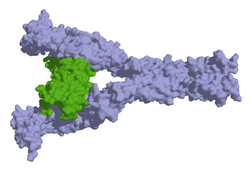Stem cell factor — (SCF), otherwise known as KIT ligand or Steel factorFreshney, Ian R. Culture of Animal Cells: A manual of basic technique . John Wiley Sons, Inc., Hoboken, New Jersey. ISBN 13 978 0 471 45329 1] ,is a cytokine which binds CD117 (c Kit). SCF is… … Wikipedia
stem cell factor — SCF. A drug being studied for its ability to increase the number of stem cells in the blood. It is a type of hematopoietic cell growth factor. Also called SCF, ancestim, and Stemgen … English dictionary of cancer terms
stem cell factor — (= SCF; Steel factor in mice; mast cell growth factor; c kit ligand) Haematopoietic growth factor, 18.6 kD from sequence; found as dimer (35 kD protein, 53 kD in its glycosylated form) … Dictionary of molecular biology
stem cell — Cell Biol. a cell that upon division replaces its own numbers and also gives rise to cells that differentiate further into one or more specialized types, as various B cells and T cells. [1880 85] * * * ▪ biology Introduction an undifferentiated… … Universalium
Stem cell niche — is a phrase loosely used in the scientific community to describe the microenvironment in which stem cells are found, which interacts with stem cells to regulate stem cell fate. The word niche can be in reference to the in vivo or in vitro stem… … Wikipedia
Stem cell — Mouse embryonic st … Wikipedia
Stem cell treatments — Many medical researchers believe that stem cell treatments have the potential to change the face of human disease and alleviate suffering. A number of stem cell treatments exist, although most are still experimental and/or costly, with the… … Wikipedia
Stem cell transplantation — Hematopoietic stem cell transplantation (HSCT) or bone marrow transplantation is a medical procedure in the field of hematology and oncology that involves transplantation of hematopoietic stem cells (HSC). It is most often performed for people… … Wikipedia
Hematopoietic stem cell — HSC=Hematopoietic stem cell, Progenitor=Progenitor cell, L blast=Lymphoblast, Lymphocyte, Mo blast=Monoblast, Monocyte, Myeloblast … Wikipedia
Induced pluripotent stem cell — Induced pluripotent stem cells, commonly abbreviated as iPS cells or iPSCs, are a type of pluripotent stem cell artificially derived from a non pluripotent cell, typically an adult somatic cell, by inducing a forced expression of certain genes.… … Wikipedia

